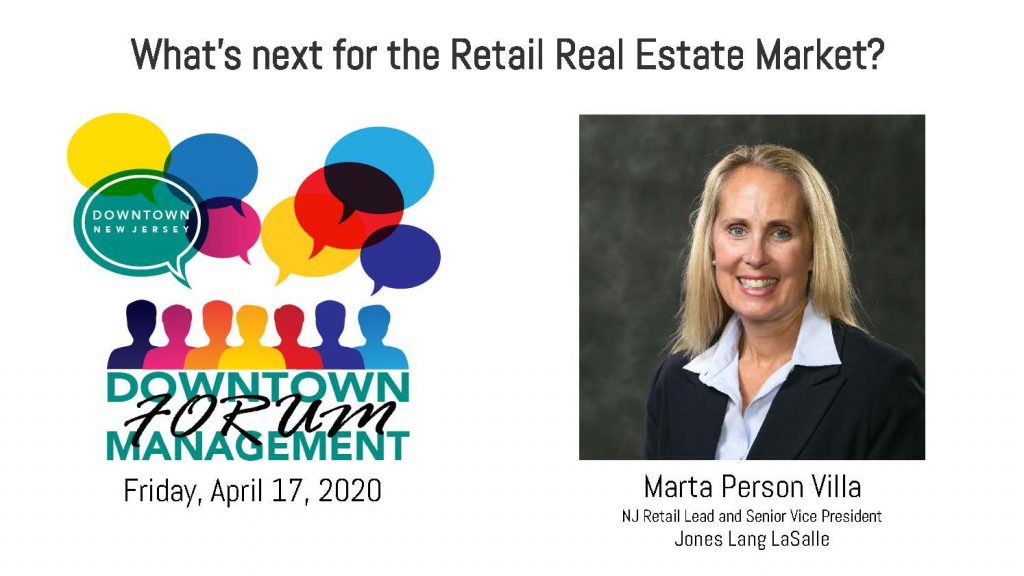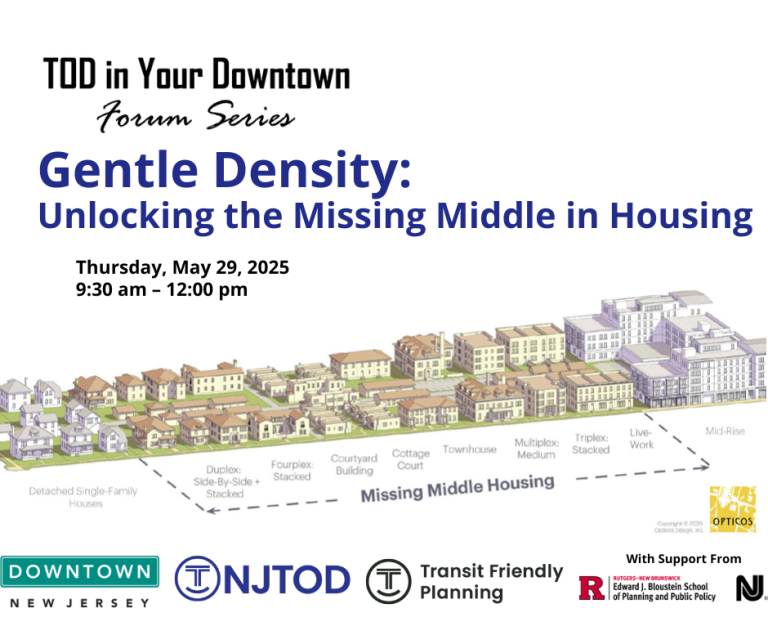What's next for the Retail Real Estate Market?
Courtenay D. Mercer, PP, AICP
Executive Director, Downtown New Jersey
Rachael Thompson Panik
Associate Planner, Mercer Planning Associates
April 17, 2020
Downtown New Jersey is providing a series of virtual opportunities for downtown managers, economic development professionals, and public officials to exchange ideas about best practices related to downtown economic development in light of the COVID-19 crisis.
At our fourth exchange on Friday, April 17, 2020, we were joined by Marta Person Villa, NJ Retail Lead and Senior Vice President with Jones Lang LaSalle and a former SID director, municipal administrator, and DNJ President. Ms. Villa discussed “what’s next” – how does your downtown recover from economic upheaval, and what can you do now to plan for a time when we’re all back to business? Using global recovery statistics as a backdrop, she showed current and imminent downtown retail occupancy conditions, and mapped out a proactive recruitment strategy to expedite recovery starting in the 3rd quarter.
Watch video:
View PowerPoint>
Meeting Summary
Marta Person Villa, NJ Retail Lead and Senior Vice President at Jones Lang LaSalle (JLL), provided an overview of the state of retail markets in downtowns in response to the COVID-19 pandemic. Marta has extensive experience working in downtowns in New Jersey; she has been a downtown manager in Cranford, Redbank, and Newark, and she has also worked as a consultant setting up BIDs in NJ. Now as JLL’s retail lead, she averages about 35 transactions a year in leases, many in urban environments. JLL’s expertise in the real estate services and extensive research can help support communities during the turbulent changes caused by the pandemic. For more information, visit JLL’s website, us.jll.com, which has many publicly available resources.
State of Retail – US and Worldwide
Unparalleled changes to the market are happening worldwide because of the pandemic. In China, stay-at-home restrictions are lifting, and businesses are beginning to open; all but cinemas have reopened in the 8 weeks since orders were lifted. Despite these openings and more people beginning to shop again, people are not shopping in their traditional patterns when compared year-over-year. Sales for Starbucks, for example, have been down 64% in the week of March 5th, and down 48% in the last week of March. Locations outside of the cities are recovering more quickly than urban areas, likely due to concerns with higher densities (and corresponding higher risk of sickness) in cities.
In Europe, things are more challenging to assess given the variety of responses from each country. Austria, for example, is starting to lift mandated closures on some stores, especially smaller shops, with strict conditions, as of March 15th. Larger services will open on May 1st.
The United States is several weeks behind Europe in terms of the pandemic’s impact. Retail markets in the United States are seeing large impacts. Essential services, like grocery stores and discount merchandisers saw major surges in March, in many cases higher than their holiday sales. It seems likely that the pandemic will catalyze retailers’ existing trajectories – retailers that survive the pandemic will be stronger than ever, and those that were already facing hardships will likely see an expedited demise. Retailers that are most likely to bounce back first from the impending recession are “open air” properties – power centers, strip centers, etc. – and those properties that are adjacent to essential services, while closed retailers, such as malls, will be slower. The most at-risk sectors of retail, as forecasted by JLL, include apparel and textiles, in-person entertainment and sports, fitness centers, car dealerships, luxury retailers, and car dealerships.
Projected vacancy rates and bankruptcy filings in the US are still in question. Before the pandemic, retail vacancy rates in NJ were less than 5% in the first quarter, which is strong, generally. In the 2008 recession, the market saw an 8% increase (total of 13% vacancy rate). Projections for retail vacancy rates in the wake of the pandemic, however, are still unclear and range widely, but the projections are being likened to a natural disaster upwards of 25%. In terms of bankruptcies, it is likely that there will be many more filings in 4Q2020 and 2021. Retailers say that for every month of recession, it takes 3-4 months to recover.
Cutting Costs and Paying Rent
In interviewing retailers, JLL found that their clients are taking a variety of steps to cut costs:
- Retailers are reserving cash as much as possible.
- Many have furloughed and laid off employees.
- Capital projects in nearly all cases have been put on hold for the remainder of 2020.
- Expansions have been limited or altogether scrapped foe the year.
- Businesses are choosing to focus on their e-commerce offerings, and they are being creative in the ways that they are making online orders and deliveries work for different products.
- They are searching for short-term financing and to their landlords for rent relief.
- Many are also considering options for long-term financing.
Landlords face their own set of challenges. They are offering rent relief where possible; those landlords who are better positioned have offered to waive rent for the month of April, while others are offering to defer rent to up to three months or even until 2021. Some landlords are linking relief to tenants applying for government relief programs. For pending new leases, tenants are asking for rent reductions. Changes of this nature often require approval from mortgages and lenders. It is in the interests of landlords to continue working closely with the retailers to accommodate them where possible, as it is unlikely that there will be new tenants lined up during the recession.
Recovery
As businesses begin to recover and reopen, services and capacities are likely to look very different than they did before the shutdown. Many retailers and businesses will adopt staggered work schedules to ensure worker and customer safety. Retailers must also consider different floor plans that will allow customers to shop while still maintaining safe distances from one another. Restaurants and fitness centers in particular will likely have changed capacity limits. Differences in capacity changes the proformas for these businesses, which may lead to the need to reduce rent costs.
What can Business Improvement Districts do?
Business Improvement Districts have the power to help local businesses during the pandemic. BIDs have statuary powers that can be invoked with board support, and may need to consider budget allocation shifts to accommodate changing needs. BID directors should “overcommunicate” with businesses and consumers using multi-channel communications to constituents during through email, social media, newsletters, etc. Communications should help businesses plan their re-entry and improve their establishments. Centralizing information for business owners about where they can get help, both using online sources and in person, will make it easier for them to succeed. BID team composition may change to accommodate more urgent needs, e.g. merchandising vs. events.
BIDs could work with banks to provide a lending package for retailers for specific needs, such as technology enhancement. BIDs could set up a “One Stop Shop” in a vacant space so business owners have direct access to staff and can ask for help. BIDs should look at zoning to ensure it says you are open for business. BIDs could use their own funds and/or partner with landlords for business attraction measures, such as façade improvements, signage, marketing expenses, etc. BIDs could help businesses by contracting with a visual merchandiser and/or industrial hygienist to help stores prepare for post-COVID expectations. As vacancies begin to appear, BIDs should consider recession resistant uses – medical facilities, liquor stores, etc.
Leasing Phase 1: Prepping for the “Front Lines”
Downtowns should continue to make aesthetic improvements to make the area feel welcoming. There must also be effort to renew marketing efforts internally through retailer events and communications – let your businesses know you are there to help and facilitate discussion among retailers. Investment in existing retailers will help boost morale. As vacancies appear, preparation is key; focus on clean, well-lit displays to show that downtown is still an inviting place to do business. Define the message that existing stores are clean and have been and have been given a “seal of approval” that they are safe for customers.
External marketing should be focusing on reaching brokers, out-of-town business owners, media, design professionals during the late summer and early fall. Let them know that downtown is open for business.
While the full extent of the pandemic is still uncertain, it is possible that vacancy rates may spike, upwards of 30%. In this case, it may take 2-3 years to reposition, similar to a ground-up development, and this is because consumers must feel confident to use the stores, and then retailers will feel comfortable expanding businesses.
Leasing Phase 2: Information, Marketing, and Communication
Organizing and expanding lists of storefront vacancy information can help the BID to strategize next steps. In addition to existing vacancies, it can be helpful to keep track of lease expirations so you can work on retaining businesses as well. For those businesses that are leaving, consider opportunities to reposition tenants – do you have the right mix of retailers and anchors in the right spaces.
Leasing packages are an important part of selling spaces to tenants. These packages are some of the stronger selling points, when equipped with the right information. Leasing packages should contain:
- Street address
- Property overview, including zoning
- Physical characteristics, including size, unique characteristics, infrastructure quality, presence of basement, etc.
- Zoning requirements
- Floor plan and site plan
- Market aerial and site aerial (with identifying logos or names) – also show residential units, train stations numbers, traffic counts
- Financial details, including rent and triple net charges
- Co-tenants, specifically recognizable brands
- Demographics (population numbers, median household income, ethnic breakdown, cell phone data, retail leakages, etc.)
- Contact information
Finally, spreading the word about available spaces is key. Printed flyers are always helpful to share with local lawyers, architects, and engineers. In addition, distribution information via CoStar, Loopnet, Crexi, social media like Linkedin, and through e-blasts can cast the net to a wider audience. As vacancies are filled, always be sure to celebrate the wins where they happen with posts/media releases, and e-blasts.
The next Downtown Management Forum will be Friday, April 24, 2020 at 11:00AM. The discussion will be led by Donna Ann Harris of Heritage Consulting Inc., a Philadelphia based firm that works nationally in downtown and commercial district revitalization. The COVID 19 pandemic has left many downtown organizations with budget shortfalls, either from special event cancellations, stalled membership drives or fundraising events that have been postponed. SID Board members are asking how to we readjust our downtown organization’s budget to deal with these new and changing realities? Ms. Harris will provide insights about the board’s role in financial oversight, and give some tips about making cuts to your budget if absolutely necessary. Registration is required, by visiting www.downtownnj.com/downtown-management-forum-covid.
Downtown New Jersey has also created a Resource Page where we are posting important updates related to legislative and policy initiatives in response to COVID 19, as well as resources from peers and experts. For more information, visit www.downtownnj.com/covid.



